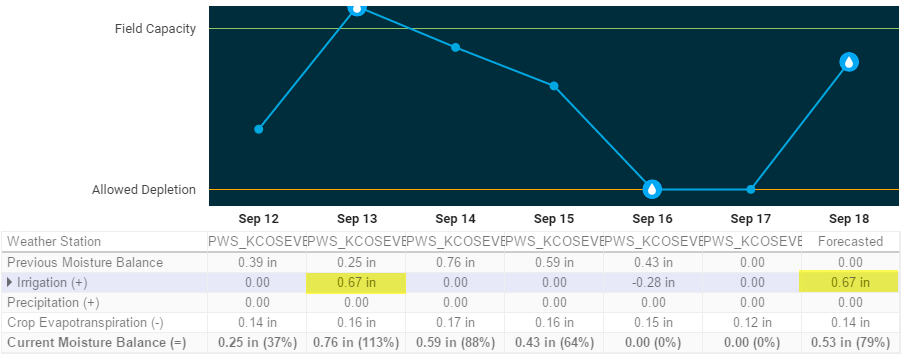I have my controller set to a fixed schedule of 60 minutes per zone. I have a custom nozzle setup @ 0.55 in\hr. Why does the irrigation number in the image below report 0.47 in ?
@ronjonp, looks like you’re using Fixed Schedules – which factor ET and other variables, including your nozzle efficiency (currently set to 75%). We’ll review your account for any irregularities and report back with our findings ![]()
If you have any other questions, please don’t hesitate to reach out.
Best, Emil
@emil Thanks for the reply. Still seems to me that if you have a nozzle set to 0.55 inches per hour & you run the schedule for an hour, it would report 0.55 inches?
This has to do with the zone efficiency setting on each zone which is incorporated into the equation that derives run time.
If the zone efficiency was equal to one, then the system running for one hour would report .55in.
Hope this helps.
![]()
@franz Still does not make sense to me. Zone efficiency is related to DU correct? If it is, then calculated PR rate is still 0.55" (96.25 x GPM / Area), it’s just not being evenly applied to the area (which will never happen 100%).
But I may be missing something … 
@franz Sounds good. I just want to know how efficiency (DU) changes the reported PR. BTW … just did a test @ 100% zone efficiency for 10 minutes & it reported 1/6 (0.092") of my 0.55" which is correct. Then I changed the efficiency to 0% & ran for 10 minutes and it reported (0.04") … seems a bit suspect that you can report anything based on 0% efficiency.
I’m just throwing this out, but is it not more accurate to think of the in/hr as a saturation amount and not a flow? I think that is what is so hard to wrap at least my head around. But the more I think of it in those terms the better. Of course I may be completely wrong and then back to the drawing board I go.
Yes
@ronjonp, sorry for the delay on getting back to you.
Efficiency, or Distribution Uniformity (DU) refers to how evenly the sprinkler system applies water to an area being irrigated. Since no irrigation system is perfect, a deduction should be applied to correct for inefficiencies, the Scheduling Multiplier (SM) is used to help estimate the additional amount of water required to achieve an acceptable appearance.
The typical practice to apply more water is to increase the run time on the controller. The SM provides guidance on how much extra time could be needed. It helps determine the upper scheduling boundary by increasing the number of minutes that sprinklers would operate to deliver an adequate amount of water. There are many other factors that influence how much extra water should be applied, including the required appearance, use of the turfgrass area, and horticultural maintenance practices. The SM also partially recognizes that there is lateral movement of water in the soil. The scheduling multiplier is based upon the following equation:
SM = 1/(0.4+(0.6*DUlq)
SM = scheduling multiplier (decimal)
DUlq = lower quarter distribution uniformity (decimal)
0.4 and 0.6 = constants
If the DUlq is below 40% (0.40), then time and effort should be spent identifying what needs to be done to assure the system is operating correctly. This may include seeking the services of a certified designer and/or contractor to identify the factors that are causing such poor performance. When the DU is low, it is hard to justify the amount of additional water needed to minimize stressed areas and achieve an acceptable appearance. When additional minutes of run time become excessive, runoff potential increases, and it becomes more difficult to do proper maintenance.
I hope this helps to address your confusion. Please let me know if you have any further questions or concerns we can address.
Best, Emil
Thanks for the reply on distribution uniformity. I still feel like my question is not being answered though. Correct me if I’m wrong but DU is used to calculate the “extra” run time needed for the critical area based on your SM derived from the efficiency?
My initial question is related to reported precipitation ![]() . IMO this reported rate should always equal (PR * RUNTIME). Seems like you could easily report gross & net precip so the users can see the impact zone efficiency has on the calculated amount of water being distributed.
. IMO this reported rate should always equal (PR * RUNTIME). Seems like you could easily report gross & net precip so the users can see the impact zone efficiency has on the calculated amount of water being distributed.
I fixed this for myself by making all my zones 100% efficiency, but I like to understand how the numbers work … hence me pestering you guys 
@emil @franz
So last night I zeroed out 3 of my backyard sprinkler zones to force the flex schedule to run. I still have my custom nozzle @ 0.55 in/hr associated with all these zones & efficiency is set to 100%. Each zone ran for 54 minutes & my reported irrigation is 0.67 inches?
How can you report 0.67 in/hr from a nozzle that outputs 0.55 in/hr on a zone that ran less than an hour?
i might be reading this wrong but if you take .67 - .25 = .42 which looks closer to correct.
maybe that previous balance is sneaking in…
Not sure I follow? The last time I had a previous moisture balance of 0.25 was 5 days ago.
well, im sorry, i was not looking at the forecasted column, if tyhis is what you are referring to. i was looking at the .67 inches you have highlighted on sep 13.
if you are talking about what you ran last night, it appears that chart has not caught up yet.
what is also cute is that you have a negative irrigation amount of -.28, not really sure how that came about unless you have purchased rachio’s moisture reducing sprinkler heads that they release on april 1st (sorry cant find the link, provided me with many funnies).
I reviewed your schedule and for this zone you have applied a watering adjustment (less water).
This will effectively allow you to water less (54 minutes vs. 1 hour) but still have the flex system appear to be watering your full amount (.67 in/hr).
Sorry if this has caused any confusion, but we chose this route so that there would be no need to modify underlying zone characteristics.
![]()
The -0.28 shows up because I emptied the zone. Previous moisture balance minus ET plus -0.28 to zero out ![]()
This is exactly what I was referring to in my previous post asking for data purity. I despise hidden adjustments that cause such confusion. Please don’t continue this method for both duration and interval adjustments. Yes, it needs to be simple, and you need to label it "longer duration / shorter duration, etc. The adjustment needs to show up in the parameters for those of us who care about the details.



